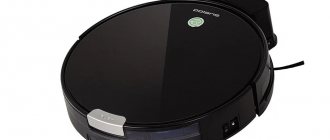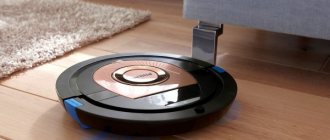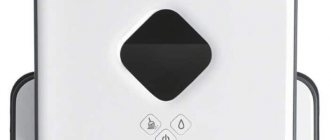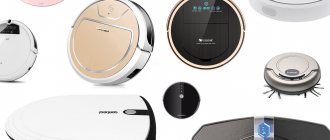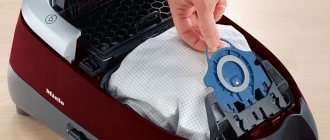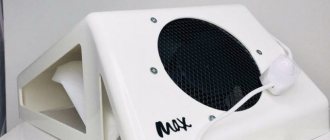Robot vacuum cleaner
Already from the name of this device you can understand that almost all processes in it are automated. The robot vacuum cleaner cleans the house without human help. Basically, all you need to do to get started is turn on this smart appliance and start the cleaning program. It should also be noted that such smart devices can clean even a room furnished with furniture. The type of flooring does not play a significant role.
Today on sale you can find models that can not only vacuum clean, but also wash the floor, while carefully “circling” places where there is carpeting, etc. By the way, the process of operating a robot vacuum cleaner is almost silent.
Karcher robot vacuum cleaner cleans the house without human help
First charging of the vacuum cleaner
Everything is extremely simple, and we will skip such basic steps as unpacking the device and unwinding the wires.
- Plug in the charging station and stash the excess cable in the appropriate pocket.
- Place the base so that there is 50 cm on each side of it and 100 cm of free space in front of it.
- Place a vacuum cleaner on the station. If everything is done correctly, the indicators on top of it will blink.
- If the indicator on the device body lights up without blinking, the battery is charged and ready for use. Press the power button.
The charge level below 20% is shown by a red indicator, less than 50% by a yellow indicator, and when the charge is sufficient, the white LED lights up.
The dimensions of Mi Robot allow it to slide under the bed. Photo: innrechmarket.com
Types of devices
There are 3 types of such devices:
- dust suction device;
- washing robot vacuum cleaner;
- robot plotters - carry out dry and wet cleaning using microfiber cloths.
The more functions such a device has, the higher its price.
Washing robot vacuum cleaner iRobot Scooba 385
Appearance
Externally, the robot vacuum cleaner looks like a small disk, or less often a rectangle. The diameter of such a structure is no more than 30 centimeters, the height is 3 times less. Due to this shape, the device can penetrate even hard-to-reach places.
The smart robot vacuum cleaner moves using three wheels with a rubberized base. The entire system is driven by a built-in electric motor.
The control panel is usually located at the top. Newer and more expensive models have a touch control panel that is protected from moisture and dust. Overall, the design of this vacuum cleaner is attractive. How does a robot vacuum cleaner work? Let's take a closer look at each type of such device.
Robot vacuum cleaner Samsung Navibot S Pop-Out
Robot vacuum cleaner for dry cleaning
Devices of this type were the very first to appear on the smart technology market. The operating principle of a robot vacuum cleaner is very similar to its wired counterpart. Dirt and dust are also captured by a brush or similar structural element. The dirt collected in this way enters the bag or container with the help of an air flow, settling safely there. At the end of cleaning, identical to a conventional vacuum cleaner, the container or bag is simply shaken out. It should be noted that the first such models were not much smaller than the usual models of vacuum cleaners that many of us use.
As for the dust collector, there are only 2 types of them - a bag and a plastic container. A plastic container can last much longer than a bag. But it is a little more difficult to clean. However, device models with a plastic container have replaceable filters. So you can just throw it away and not have to worry about cleaning it.
When choosing a robot vacuum cleaner model, you need to consider the capacity of the dust collector. The intensity of house cleaning will depend on this. As a rule, if you choose a device with a plastic container, a set of replacement filters is included.
Roomba 776, robot vacuum cleaner for dry cleaning
How does a robot vacuum cleaner work?
The start of operation of the robot vacuum cleaner is invisible to humans. The car first turns on the navigation system. With its help, the vacuum cleaner collects data about the size of the room, the location of furniture and other objects.
The thinking system analyzes the collected data. Based on them, a route is drawn up and a trajectory is selected. This can be a progressive linear progression from one wall to another or a spiral trajectory from the center of the room to the edges.
If an obstacle is encountered on the way of the smart robot vacuum cleaner, it will bypass it and continue its work.
Robot vacuum cleaner for wet cleaning
In this case, there are 2 types of devices: one works on the principle of a plotter, and the other carries out step-by-step cleaning. The robot vacuum cleaner operates on the plotter principle using a special microfiber cloth. The rag itself is attached to the nozzle, after which cleaning is carried out with water and detergent liquid, which is located in the middle. Essentially, this is the same as washing the floor with a regular mop, but the process is fully automated.
As for the step-by-step robot vacuum cleaner, everything is somewhat more complicated. First, the device sprays liquid over the contaminated surface. Next, using special brushes, the area is intensively rubbed. At the end of this stage, the soaked dirt is simply sucked into a special container. At the final stage, the robot vacuum cleaner removes remaining moisture using a rubber or silicone scraper. The end result is a completely clean and dry surface. Water along with washing liquid is in a special tank, which is made of impact-resistant plastic. As for the collection of dirt and water, only a plastic container with replaceable filters is used here.
Comparing these two subtypes of “smart” home appliances, we can say that the step-by-step model of the device performs cleaning much better.
Robot vacuum cleaner Panda X900 Wet Clean with water
How to clean a robot vacuum cleaner
Cleaning the device includes several mandatory steps. It is necessary to thoroughly clean all major parts of the equipment from contamination. This must be done regularly; the service life of individual spare parts and the vacuum cleaner itself depends on how the owner takes care of the equipment.
Emptying the trash bin
The container of the robot vacuum cleaner must be removed from the body and cleaned. Garbage bins are not recommended to be washed under running water due to the fact that they are equipped with a motor. Washing the container will cause it to break. To maintain cleanliness, the garbage container is thoroughly cleaned with a brush and wiped on top with a damp soft cloth.
Cleaning the filter
This is done every time after cleaning. This contributes to better dust absorption by the device. The filter needs to be changed every 2 months or more often if the device no longer removes dirt well.
Cleaning the central brushes
They need to be removed; simply wiping and removing dust from the outside is not enough. If you do not remove the brush and do not properly care for it, there is a risk of its premature failure. Additionally, it is necessary to clean the place where it is installed, because dust gets clogged under the bearing caps that secure the brush.
Cleaning the side brushes
Depending on the device model, the number of brushes varies - one or two, as in iBoto Aqua. They must be removed before cleaning. Regular maintenance of side brushes is weekly.
Guide wheel
If you do not take care of it, the speed of movement of equipment around the room will significantly decrease. This occurs due to the fact that debris is wound onto its axis during operation of the robot. It is necessary to remove the wheel in order to clean it of animal hair and hair; if this is not done, then removing dirt from it will take a lot of time.
Caring for Touch Sensors
They are located on the top side of the device. To keep them running smoothly, you need to keep them clean. It is necessary to wipe them with a napkin after each cleaning. An important point is that you cannot use wet cloths to wipe touch sensors, only dry ones. Moisture can disrupt their operation, causing the sensors to display erroneous data or stop functioning.
Internal cleaning of the vacuum cleaner
It is advisable to clean the inside of the vacuum cleaner once every six months. This is due to the fact that during operation dust may enter the body of the equipment. Cleaning can be carried out independently, or if the owner of the vacuum cleaner has doubts that it will cope with this work, it is worth contacting a specialized service center for servicing robotics.
Knowing how to clean a robot vacuum cleaner will help keep it working longer. You won’t have to replace parts that have failed due to poor equipment maintenance. This means it will be possible to reduce the cost of its maintenance.
Robot plotter
You can also find a mixed-type robot vacuum cleaner on sale. It carries out both dry and wet cleaning. However, it should be noted that this type of home equipment is not very suitable for allergy sufferers. This robot cleans using a rag or microfiber cloth. Also, a model of this type will not clean absolutely the entire floor covering. Preference is given to the following flooring material:
- tiles;
- laminate;
- linoleum;
- varnished parquet.
As for carpet material, there are limitations - this type of automated equipment will not clean material with a pile longer than 3-4 millimeters.
Overall, this stand-alone vacuum cleaner is perfect for office spaces or apartments without carpet. Since it can carry out both dry and wet cleaning, which significantly reduces the overall cleaning time.
Moneual robot plotter for dry and wet cleaning
What else is good about a robot vacuum cleaner?
Can clean in your absence
A robot vacuum cleaner not only does your homework for you, but can also do it without your presence. Almost all models can be programmed to clean at certain hours.
Can pick up pet hair with the turbo brush
A turbo brush is a roller with bristles or rubber blades. It is driven by an electric motor. The turbo brush does a good job of picking up and pushing debris, including wool, towards the suction hole.
Device diagram
Despite the fact that models of such cleaning equipment may differ in their functions, the scheme is almost the same. Most automated vacuum cleaners are assembled from the following components:
- battery;
- module with brushes;
- module with wheels;
- container for collecting garbage and dust;
- liquid reservoir (if it is a washing vacuum cleaner);
- paddle brush;
- housings;
- removable top panel.
Also included is always a charger for the robot.
Movement in space
The way such a home assistant carries out cleaning is understandable. But by what principle does he “drive” around the house, and how does he recognize obstacles in his path? The robot vacuum cleaner navigates in space using one of the following technologies:
- laser rangefinder;
- ultrasonic rangefinder;
- according to the “virtual wall” principle;
- contact sensor;
- infrared sensor.
An ultrasonic rangefinder measures the distance between an object that is in the path of the vacuum cleaner and the equipment itself, transmitting the data to the robot. Thus, the smart home assistant does not crash into furniture or walls.
The robot vacuum cleaner uses an ultrasonic rangefinder to measure the distance between objects
As for the laser rangefinder, it simply scans the space and forms a kind of “map” for the operation of the vacuum cleaner itself. In addition to the fact that this way the equipment will not crash into objects, cleaning is carried out more efficiently and quickly.
Models with a contact sensor work on a completely different principle. There are special sensors along the edges of the vacuum cleaner. When they come into contact with an object, they send a signal to the robot, and it simply goes around the obstacle.
The virtual wall allows you to set restrictions on the operation of equipment. This limiter works using an infrared sensor. For example, if you want cleaning to be carried out only in one specific room, models with this function will be very useful.
The virtual wall allows you to set restrictions on the operation of the robot vacuum cleaner
Models with an infrared sensor will be relevant in rooms with stairs. It is this function that prevents the robot from falling from a height while cleaning. Also, some models have a special cleaning algorithm that can be adjusted by the user. Additional sensors can carefully scan the area for particularly dirty areas. The vacuum cleaner will clean such places longer and more intensively.
Modern models have an additional system for recognizing difficult areas. For example, if the robot gets tangled in wires while cleaning, the functioning of the entire system will stop until the device moves away from the dangerous area. Also, such models have a special sensor to recognize the type of surface. Thus, cleaning will be carried out as carefully and efficiently as possible.
Cleaning schedule
Models even in the mid-price category have an important function - the user can set a cleaning schedule. At the right time, the robot will automatically activate and begin cleaning the house. Some models have an additional remote control.
When the device's charge is running low, the system automatically directs the robot to the charger. Using special sensors, the vacuum cleaner itself finds the connection location. When charging is complete, it can automatically continue working.
The robot vacuum cleaner finds the charger itself
How to set up the robot vacuum cleaner app
How to control a Xiaomi robot vacuum cleaner via phone is a question that interests almost every Mi Robot owner. There is a special Xiaomi application through which you can set a cleaning schedule and other parameters for the home assistant.
- Download the Mi Home app for Android or iOS.
- After starting the program, select the server. It is better to indicate Europe, USA or Singapore, since some options are blocked on Chinese servers.
- Log in to your account or register.
- In the add device item, select Mi Robot from the list.
- On the vacuum cleaner, press the button with the house icon and hold it for at least 5 seconds until the beep sounds. It indicates that the device has successfully connected to the application.
- Select Mi Robot again and specify your home Wi-Fi network.
- Set the robot's primary location, such as Living Room, and complete the setup.
Having completed these manipulations, you will be able to control the vacuum cleaner through the application, even when you are not at home.
MiJia 1C (white) is thinner than Mi Robot Vacuum Mop P (black) and fits under almost any furniture. Photo: smartrobotreviews.com
